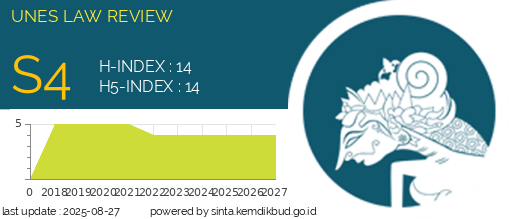Perlindungan Represif dalam Awig-Awig di Bali pada Penyelesaian Sengketa Adat
DOI:
https://doi.org/10.31933/unesrev.v6i4.1939Keywords:
Repressive Protection, Awig-Awig, Customary DisputesAbstract
The aim of this research is to explore the concept of repressive protection for customary disputes in Indonesia and explore the manifestation of repressive protection for Awig-Awig in Bali in resolving customary disputes. This research method is normative juridical, with a statutory, conceptual legal and legal case approach. Data comes from secondary sources, including primary legal materials, secondary legal materials and tertiary legal materials. Data analysis is descriptive analytical. The results of the research found that the concept of repressive protection for customary disputes in Indonesia is in the form of protecting indigenous peoples by enforcing the law as well as imposing sanctions on law violators. The legal certainty is as stated in the Constitution of the Republic of Indonesia of 1945 and Law of the Republic of Indonesia Number 6 of 2014 concerning Villages. The embodiment of this protection in Awig-Awig is as an example in Bali, where there are regulations regarding the rights of indigenous peoples as well as their application when disputes occur. Those who violate will be subject to sanctions.
Downloads
References
Bediona, K., dkk. (2024). “Analisis Teori Perlindungan Hukum Menurut Philipus M Hadjon Dalam Kaitannya Dengan Pemberian Hukuman Kebiri Terhadap Pelaku Kejahatan Seksual”. Das Sollen: Jurnal Kajian Kontemporer Hukum Dan Masyarakat, Vol. 2, No. 01.
Ernawati & Baharudin, E. (2019). “Dinamika Masyarakat Hukum Adat dalam Sistem Ketatanegaraan di Indonesia”. Hukum dan Keadilan, Vol. 6, No. 2.
Faisal, Emil El & Mariyani. (2021). Buku Ajar Filsafat Hukum. Palembang: Bening Media Publishing.
Hastuti, MDM. (2023). “Hukum Adat Bali di Tengah Arus Budaya Global dan Modernisasi Pembangunan”. Jurnal Hukum Lex Generalis, Vol. 4, No. 3.
Junia, Ie Lien R. (2023). “Mengenal Hukum Adat Awig-Awig di Dalam Desa Adat Bali”. Jurnal Hukum dan HAM Wara Sains, Vol. 02, No. 09.
Kusuma, Ayu Amalia. (2015). “Efektivitas Undang-Undang Perlindungan Anak dalam Hubungan dengan Perlindungan Hukum terhadap Anak Korban Perdagangan Orang di Indonesia”. Jurnal Lex et Societatis, Vol. 3, No. 1.
Rukajat, A. (2018). Pendekatan Penelitian Kualitatif (Qualitative Research Approach). Yogyakarta: Deepublish.
Sari, Ni Luh A. (2024). “Penguatan dan Penegakan Aturan-Aturan Adat (Awig-Awig) untuk Melindungi Eksistensi Tanah Adat di Lombok”. Jurnal Ganec Swara, Vol. 18, No.1.
Yulianingsih, Wiwin. Apriyani, Maria N. Simangunsong, Frans. (2022). Hukum Adat Awig-Awig Masyarakat Lombok dalam Pelestarian Sumber Daya Alam Laut. Yogyakarta: KYTA.
Yulianingsih, Wiwin. Indawati, Yana., Kartika, Adhitya W. (2020). Awig-Awig Sebagai Hukum Adat Tertulis dalam Perspektif Hukum Adat di Indonesia. Surabaya: Mitra Abisatya
Downloads
Published
How to Cite
Issue
Section
License
Hak cipta :
Penulis yang mempublikasikan manuskripnya di jurnal ini menyetujui ketentuan berikut:
- Hak cipta pada setiap artikel adalah milik penulis.
- Penulis mengakui bahwa UNES Law Review berhak menjadi yang pertama menerbitkan dengan lisensi Creative Commons Attribution 4.0 International (Attribution 4.0 International CC BY 4.0) .
- Penulis dapat mengirimkan artikel secara terpisah, mengatur distribusi non-eksklusif manuskrip yang telah diterbitkan dalam jurnal ini ke versi lain (misalnya, dikirim ke repositori institusi penulis, publikasi ke dalam buku, dll.), dengan mengakui bahwa manuskrip telah diterbitkan pertama kali di Jurnal UNES Law Review.



















